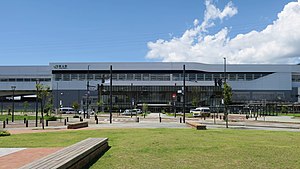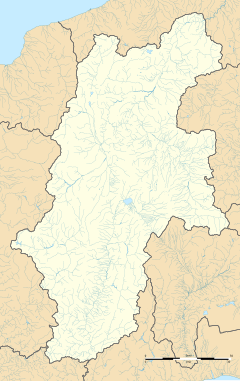Iiyama Station 飯山駅 | ||||||||||||||||
|---|---|---|---|---|---|---|---|---|---|---|---|---|---|---|---|---|
 Iiyama Station Chikumagawa exit in July 2022 | ||||||||||||||||
| General information | ||||||||||||||||
| Location | Iiyama, Iiyama-shi, Nagano-ken 389-225 Japan | |||||||||||||||
| Coordinates | 36°50′52″N 138°21′33″E / 36.8477°N 138.3592°E | |||||||||||||||
| Operated by |
| |||||||||||||||
| Line(s) | ||||||||||||||||
| Platforms | 1 island platform + 2 side platforms | |||||||||||||||
| Tracks | 4 | |||||||||||||||
| Connections | Bus stop | |||||||||||||||
| Other information | ||||||||||||||||
| Status | Staffed (" Midori no Madoguchi") | |||||||||||||||
| Website | Official website | |||||||||||||||
| History | ||||||||||||||||
| Opened | 20 October 1921 | |||||||||||||||
| Passengers | ||||||||||||||||
| FY2021 | 719 daily | |||||||||||||||
| Services | ||||||||||||||||
| ||||||||||||||||
| Location | ||||||||||||||||
Iiyama Station (飯山駅, Iiyama-eki) is a railway station on the Iiyama Line in the city of Iiyama, Nagano Prefecture, Japan, operated by East Japan Railway Company (JR East). Since 14 March 2015, it is also a stop on the high-speed Hokuriku Shinkansen line from Tokyo to Kanazawa.
Lines
Iiyama Station is served by the Iiyama Line, and is 19.2 kilometers from the starting point of the line at Toyono Station. From 14 March 2015, it also became a stop on the high-speed Hokuriku Shinkansen line from Tokyo to Kanazawa, located 147.3 km from the official starting point of the line at Takasaki. [1] Iiyama is served by Hakutaka services operating between Tokyo and Kanazawa, although not all trains will stop at Iiyama. [2]
Station layout
The new station structure built to coincide with the opening of the Hokuriku Shinkansen extension lies approximately 300 m (980 ft) to the south of the site of the original station. [1] The elevated Shinkansen platforms cross the ground-level Iiyama Line platforms at an angle. [1] The station has a " Midori no Madoguchi" staffed ticket office.
Platforms
The Iiyama Line is served by a ground-level island platform with tracks on either side.
| 1 | ■ Iiyama Line | for Toyono and Nagano |
| 2 | ■ Iiyama Line | for Togarinozawa-Onsen, Tōkamachi and Echigo-Kawaguchi |
The Shinkansen platforms consist of two 312 m long side platforms serving two tracks. The platforms are fitted with chest-high platform edge doors. [1]
| 11 | ■ Hokuriku Shinkansen | for Nagano, Takasaki and Tokyo |
| 12 | ■ Hokuriku Shinkansen | for Toyama and Kanazawa |
History

Iiyama Station opened on 20 October 1921. [3] With the privatization of JNR on 1 April 1987, the station came under the control of JR East. [3]
The new station structure opened on 9 November 2014. [4]
Passenger statistics
In fiscal 2021, the station was used by an average of 719 passengers daily (boarding passengers only). [5] Passenger figures for previous years are as shown below.
| Fiscal year | Daily average |
|---|---|
| 2000 | 723 [6] |
| 2005 | 636 [7] |
| 2010 | 572 [8] |
| 2015 | 1012 [9] |
| 2020 | 635 [10] |
Surrounding area
- Iiyama City Hall
 National Route 117
National Route 117- Chikuma River
See also
References
- ^ a b c d 北陸新幹線延伸開業区間新駅ガイド [Guide to new stations on the Hokuriku Shinkansen extension]. Tetsudō Daiya Jōhō Magazine (in Japanese). Vol. 44, no. 371. Japan: Kōtsū Shimbun. March 2015. pp. 15–23.
- ^ 長野~金沢間のあらまし [Outline of route between Nagano and Kanazawa]. Tetsudō Daiya Jōhō Magazine (in Japanese). Vol. 44, no. 371. Japan: Kōtsū Shimbun. March 2015. pp. 12–14.
- ^ a b Ishino, Tetsu, ed. (1998). 停車場変遷大辞典 国鉄・JR編 [Station Transition Directory - JNR/JR]. Vol. II. Japan: JTB. p. 592. ISBN 4-533-02980-9.
- ^ 各駅の乗車人員 (2021年度) [Station passenger figures (Fiscal 2021)] (in Japanese). Japan: East Japan Railway Company. 2022. Retrieved 24 January 2023.
- ^ 各駅の乗車人員 (2000年度) [Station passenger figures (Fiscal 2000)] (in Japanese). Japan: East Japan Railway Company. 2001. Archived from the original on 2 April 2019. Retrieved 15 February 2015.
- ^ 各駅の乗車人員 (2005年度) [Station passenger figures (Fiscal 2005)] (in Japanese). Japan: East Japan Railway Company. 2006. Archived from the original on 2 April 2019. Retrieved 15 February 2015.
- ^ 各駅の乗車人員 (2010年度) [Station passenger figures (Fiscal 2010)] (in Japanese). Japan: East Japan Railway Company. 2011. Retrieved 15 February 2015.
- ^ 各駅の乗車人員 (2015年度) [Station passenger figures (Fiscal 2015)] (in Japanese). Japan: East Japan Railway Company. 2016. Retrieved 11 December 2016.
- ^ 各駅の乗車人員 (2020年度) [Station passenger figures (Fiscal 2020)] (in Japanese). Japan: East Japan Railway Company. 2021. Retrieved 24 January 2023.
External links
- JR East station information (in Japanese)

